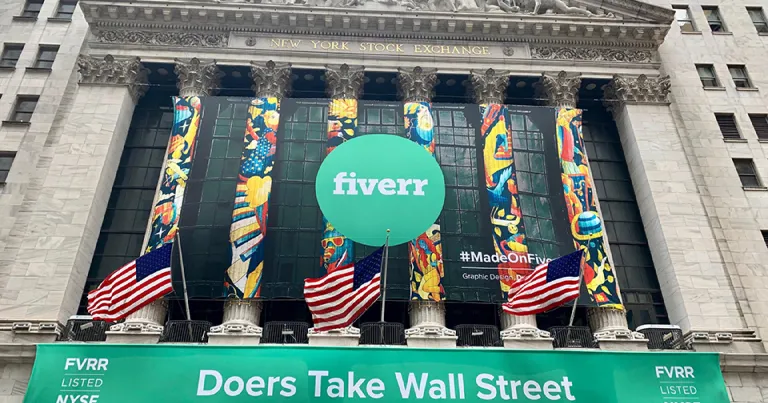Fiverr has been making waves in the online freelance world, but recently, its stock has seen a notable dip. If you're scratching your head wondering why this is happening, you're not alone. Investors, freelancers, and industry watchers alike are curious about the factors influencing the company’s stock performance. In this post, we'll delve into Fiverr's business model to better understand the core of the company, its revenue streams, and how the market dynamics could be affecting its stock price.
Overview of Fiverr's Business Model

Fiverr operates as a digital marketplace that connects freelancers offering services—referred to as "gigs"—with clients seeking those services. But how does it all work? Let's break it down:
- Freelancer Engagement: Anyone can sign up as a seller on Fiverr to offer their skills, ranging from graphic design to writing, programming, and digital marketing. Sellers create profiles, list their services, and set their prices starting from just $5.
- Service Categories: Fiverr offers a broad range of categories, including:
- Graphic & Design
- Digital Marketing
- Writing & Translation
- Video & Animation
- Programming & Tech
- Revenue Model: Fiverr generates revenue by charging a commission on each transaction. When a seller completes a gig, Fiverr takes a cut—typically around 20%—from the earnings. For instance, if a freelancer charges $100 for a service, they receive $80, while Fiverr keeps $20.
- Freemium Approach: Fiverr has adopted a freemium model, allowing sellers to join for free while offering premium services at various levels. This encourages a vast pool of freelancers to join the platform, creating diverse service offerings for buyers.
- Global Reach: One of Fiverr's significant advantages is its international marketplace. Businesses from all over the world can connect with freelancers, expanding the potential customer base and service diversity.
In essence, Fiverr's business model thrives on a simple principle: it connects buyers to freelancers while facilitating transactions and creating a space for creative talents to flourish. Understanding this model can shed light on the reasons behind its stock fluctuations and what investors should keep an eye on moving forward.
Also Read This: How to Gain Gigs from Fiverr
3. Recent Financial Performance

Fiverr has been attracting attention on the stock market, but its recent financial performance raises quite a few eyebrows. For those unfamiliar, Fiverr is a popular online marketplace for freelance services. In an ever-competitive environment, how does Fiverr's financial health stack up?
First off, let’s look at the numbers. In its recent earnings report, Fiverr posted a revenue that fell short of analysts' expectations. This missed target often signals potential trouble for companies, causing investors to rethink their positions. Here are some key figures:
- Revenue Growth: Despite showing some level of growth year-over-year, it has not been at the rate many hoped for.
- Net Income: Fiverr reported a net loss, which did not sit well with shareholders looking for profitability.
- Customer Acquisition Costs: With increasing costs associated with attracting new customers, questions arise about sustainability.
These financial metrics paint a complicated picture. Investors often take these factors into account to make decisions. If a company isn't hitting its revenue goals or becomes less efficient in operations, it can trigger a drop in stock prices. So, while Fiverr has established a solid reputation, its recent performance indicates the need for strategic shifts to regain investor confidence.
Also Read This: How to Sell Services on Fiverr
4. Market Trends Affecting Fiverr

The freelance economy is ever-evolving, and Fiverr finds itself navigating through changing market trends that significantly impact its stock performance. First and foremost, let’s talk about the gig economy. The rise of remote work has boosted demand for freelance services, which initially seemed beneficial for platforms like Fiverr. However, there are more layers to this story.
Current trends include:
- Increased Competition: With numerous platforms popping up, Fiverr faces stiff competition from other gig marketplaces. This saturation may lead to price wars and reduced margins.
- Market Demand Shifts: As businesses adapt post-pandemic, the type of services in demand is changing. Fiverr must pivot quickly to align with what employers need.
- Regulatory Challenges: Freelancers can face various legal and tax implications which might discourage potential users from engaging in online freelance work.
In addition, shifts in the broader economy, like rising inflation and interest rates, might make businesses more conservative in their spending, ultimately affecting their willingness to hire freelancers through platforms like Fiverr. Keeping an eye on these market trends can help stakeholders understand not just Fiverr's current challenges but also its pathways to future success. So, while the stock drop might seem alarming, it’s essential to evaluate the underlying market dynamics at play.
Also Read This: How to Start on Fiverr: A Comprehensive Guide for Beginners
Competition and Industry Landscape
When we talk about Fiverr and the dynamics affecting its stock price, it’s impossible to ignore the competitive landscape. Fiverr operates in the gig economy—an exciting space but one filled with numerous players, both established and emerging. So, why is this competition hurting Fiverr stock?
First, let’s consider the key competitors. Alongside Fiverr, there are platforms like Upwork, Freelancer, and even newer entrants that are nipping at its heels. Each of these platforms offers contest-like project structures or freelancer-focused services that can dilute Fiverr's unique position in the market. For example:
- Upwork: Known for its robust project management tools and a vast range of freelance roles, it appeals to businesses looking for long-term collaborators.
- Freelancer.com: Offers a similar bidding system but often at lower costs, attracting budget-conscious clients.
- Guru: Focuses on a niche that includes tech and creative industries, creating specific competition for Fiverr's service categories.
This surge in competition means that Fiverr has to continuously innovate and possibly invest heavily in marketing, technology, and talent—factors that can strain financial performance. All of this leads to uncertainty. Investors get jittery when they think competitors may take away Fiverr’s market share, which ultimately reflects in their stock value.
Also Read This: How to Solve Your DNIDE Profile Issues on Fiverr
Investor Sentiment and Market Reactions
Investor sentiment is a powerful force in the stock market, and it seems that recent events have painted Fiverr in a less-than-rosy light. You see, stock prices don't just move based on a company's financial metrics; they also react to public perception and media coverage.
When news emerges about declining user numbers or stagnant revenue growth, it can send investors scrambling. Here’s how some factors play into sentiment:
- Earnings Reports: If Fiverr’s earnings report underperforms expectations, it's likely that investors will sell off shares, leading to a drop in stock prices.
- Guidance Outlook: If Fiverr projects conservative revenue growth for the next quarter, that could trigger a negative reaction, potentially causing the stock to dip further.
- Market Trends: Broader market trends towards tech stocks can also heavily influence Fiverr. If there's a general downtrend affecting tech companies, Fiverr is not insulated from those reactions.
Moreover, social media and forums like Reddit can amplify concerns, leading to fast swings in stock trading. Negative sentiment on platforms can lead to panic selling, further pressuring Fiverr stock to drop. All of this demonstrates that while fundamentals matter, investor sentiment is truly a double-edged sword and a critical driver of Fiverr’s stock performance.
Also Read This: Promoting Your Freelance Services
Future Outlook for Fiverr Stock
When we talk about the future outlook for Fiverr's stock, it’s a mixed bag, filled with both promise and challenges. As the gig economy continues to grow, it stands to reason that Fiverr could reap the benefits of an ever-expanding market. But there are several factors we need to consider that might impact Fiverr's performance in the coming years.
Here's what we should keep an eye on:
- Market Trends: The gig economy is predicted to keep growing. Freelancers are becoming increasingly popular, and platforms like Fiverr could benefit significantly from this ongoing trend.
- Competition: As Fiverr expands, competition from other freelance platforms like Upwork, Freelancer, and even newer players could increase. The ability to keep pricing competitive without sacrificing quality will be crucial.
- Diversification of Services: Fiverr has been working on diversifying its offerings beyond freelance gigs. This could enhance its market position and attract different user demographics. We may see growth in areas like Fiverr Learn or Fiverr Business, catering to larger entities.
- User Experience: Improving the platform's user experience through features like better search optimization and enhanced customer support will be vital for user retention. A happy customer is likely to return, thus impacting revenue positively.
In summary, while there are potential challenges on the horizon, Fiverr also possesses a strong foundation and opportunities for growth. Investors will need to look closely at these factors when assessing the stock's future viability.
Conclusion
In wrapping up, the decline in Fiverr's stock can be attributed to a combination of operational challenges, stiff competition, and market sentiment shifts. However, it’s essential to understand that the stock market is a turbulent place, influenced by both micro and macroeconomic factors.
Moreover, Fiverr still holds considerable potential in a rapidly growing gig economy. With the right strategies in place—such as enhancing user experience, diversifying services, and navigating competitive pressures—Fiverr can regain investor confidence and possibly restore its stock performance. Here’s how potential investors might summarize key takeaways:
| Key Takeaways | Implications |
|---|---|
| Market Growth | Gig economy continues to thrive; Fiverr could benefit. |
| Competitive Landscape | Increased competition may pressure pricing and margins. |
| Diversity of Offerings | Expanding services could attract new customers. |
| User Experience | Enhanced features can help retain and expand the user base. |
In conclusion, while Fiverr may be facing some stormy seas at the moment, its long-term future remains a subject of interest. With innovative strategies and a focus on user satisfaction, the stock could find its way back into favorable waters.



